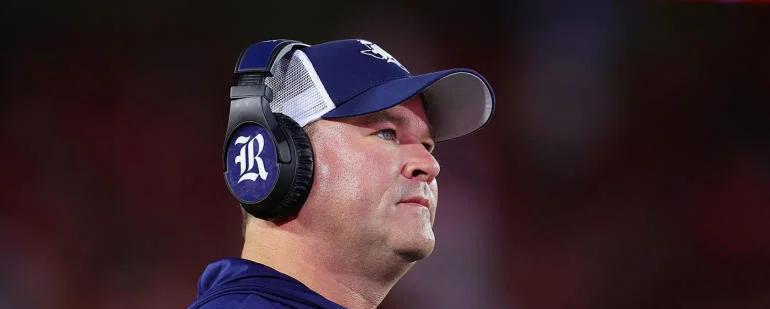•
Written By
Written By
•
•
•
Loading article...
Written By
Written By
Written By
Omar-Rashon Borja
Senior Writer, Editor, Historian
Written By
Omar-Rashon Borja
Senior Writer, Editor, Historian

The Mike Bloomgren Era at Rice is over. On the surface, firing a coach with a 24-52 record across six-plus seasons is self-explanatory, but there is much to analyze with added context. Additionally, Bloomgren's tenure generates questions about the philosophy of coaching tenures in the Transfer Portal era of college football.
It is not a stretch to say Mike Bloomgren was one of Rice's greatest coaches since the 1960s. For context, Rice had zero bowl appearances from 1962 to 2005. Since making the 2006 New Orleans Bowl to break the drought, the Owls have made six bowls in 17 seasons.
Bloomgren has two of those bowl appearances. Additionally, Bloomgren led Rice to a program-defining victory in 2020 when they upset #15 Marshall 20-0. The win was Rice's first win over a ranked team since 1997, its first road win over a ranked team since 1991, and its first shutout of a ranked team since 1960.
Finally, Bloomgren helped Rice stay relevant enough to pull them out of Conference USA and into the American Athletic Conference. Of course, Rice's location in Houston had much to do with this. However, had the events of the current realignment cycle occurred from 2016-2017, the two years before Bloomgren took over, AAC likely overlooks Rice. The Owls went 4-20 two years before Bloomgren took over. Thus, Bloomgren deserves some credit for Rice's AAC move.
With this in mind, one can consider Mike Bloomgren's tenure successful. However, in the current age of college football, it is difficult to imagine a coach could last six years with this body of work.
Rice is the perfect spot for a coach to build their program gradually. The college football world left Rice behind a long time ago. In the wild days of the Southwest Conference, the Owls were either not cheating as much as their conference mates or not even cheating. When the Big 12 grabbed half of the remnants of the Southwest Conference, Rice was one of the misfits banished to the WAC and Conference USA.
Expectations at Rice are low, and they seem content with that fact. Even when the Owls have worse competition to compete with and fewer excuses now that they have long been gone from the Southwest Conference, the leash remains long for coaches.
Bloomgren's firing coincides with back-to-back years where "big name" transfer portal quarterbacks led the team. In 2023, journeyman J.T. Daniels led Rice to its first bowl since 2014. This year, expectations were high when two-time 3,000-yard passer E.J. Warner arrived from Temple. Ideally, two bowl appearances at Rice, their fifth and sixth appearances since 1962, should have bought Bloomgren enough time. However, he proved he could win with the portal. Consequently, that was the expectation.
Additionally, coaches winning immediately at the country's toughest jobs did not help Bloomgren's cause. Bryant Vincent has Louisiana-Monroe in the Sun Belt Conference championship mix for only the third time this millennium. ULM consistently has the FBS' lowest athletic budget. Their lack of success at the FBS level shows this. The Warhawks have just one bowl appearance in over three decades as an FBS school.
New Mexico State went to back-to-back bowls in 2022 and 2023, their second and third bowl appearances since 1960. They also went to the conference championship and beat Auburn in 2023.
The brass in Rice's athletic department had to see these events play out and wonder, "Why not us?" Bloomgren arguably opened Pandora's Box with his success with the transfer portal.
Last year, every wealthy donor connected to SMU came out in droves to fund the Mustangs' move to the ACC. So far, the Mustangs' upward move has paid off. SMU is already an ACC contender.
Rice is an academically revered institution and should have several wealthy donors. The donors could band together to get Rice an elite coach from the Group of Five, right? Or a genius young coordinator like Brennan Marion?
To put it bluntly, it does not seem like Rice's donors care about football. The fact it has been so long since Rice was nationally relevant plays a significant role in this.
SMU's golden era occurred in the early 1980s. Several older donors probably attended SMU during their peak and felt moving to the ACC could bring back the golden days.
Rice's last golden age was in the early 1960s when they went to the Sugar Bowl in 1960 and the Bluebonnet Bowl in 1961. Their final outright Southwest Conference title and Cotton Bowl appearance was in 1957. Very few, if any, Rice boosters were alive during this time. The "good times" for Rice donors were likely the 1994 Southwest Conference title shared with four other teams or the 2013 Conference USA championship. For these boosters, there is no grandiose picture of Rice football to draw from, so why donate?
This context puts Rice at a significant disadvantage with its AAC counterparts. The transfer portal is an equalizer, but what use is it without a substantial NIL trove?
Mike Bloomgren's tenure is an intriguing study on changing trends in college football. Should schools expect coaches to reverse generational trends with the transfer portal? Should schools with traditionally low ceilings still commit to patience with coaching hires? Should private schools like Rice expect more from distinguished alumni in the NIL sphere? Rice's next move could be the blueprint for each of these questions.
Rice defeated No. 21 Marshall 20-0 today, leading to plenty of firsts in a while for the Owls: - First win vs ranked opponent since 1997 (BYU) - First road win vs ranked opponent since 1991 (Baylor) - First shutout of ranked opponent since 1960 (Texas)